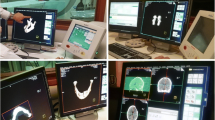Abstract
Purpose
One of the key challenges during orbital fracture reconstructive surgery, due to the complex anatomy of the orbit, is shaping and trimming the precise contour of the implants. The objectives of this study were to describe and evaluate the use of a three-dimensional (3-D) printing technique for personalized reconstructive surgery for repairing orbital fractures.
Methods
A total of 29 cases which had 3-D technique-assisted surgical reconstruction, and 27 cases which had traditional surgery, were retrospectively analyzed. Preoperative and postoperative CT images were measured using MIMICS software, and the contour of the fracture zone and the Medpor-titanium implant were analyzed and compared. The surgical duration was also compared between the two groups.
Results
There were statistically significant differences in the maximum width, depth and area between fracture zone and implant between the two groups, with the absolute value in the 3-D group markedly lower as compared to the control group. In addition, the difference in the medial-inferior wall angle between the surgical eye and healthy eye was also statistically significant between the groups. The average surgical duration in the 3-D group was substantially shorter than in the control group. Additionally, the postoperative clinical evaluation in the 3-D group was superior to that of the control group.
Conclusion
The 3-D printing technique is of great value for predicting the precise fracture zone before, and during, personalized surgery, and can help surgeons achieve accurate anatomical reconstruction for repairs of blowout orbital fractures. Moreover, the simulated bone template produced by 3-D printing models allows for “true-to-original” orbital reconstruction, which can shorten the surgical duration and improve the accuracy and safety of the operation.






Similar content being viewed by others
References
Al-Sukhun J, Lindqvist C, Kontio R (2006) Modelling of orbital deformation using finite-element analysis. J R Soc Interface 3:255–262. doi:10.1098/rsif.2005.0084
Ohta N, Inamura H, Koike S, Aoyagi M (2011) Clinical study of blow out fracture. Pract Otol Suppl 130:56–59
Brucoli M, Arcuri F, Cavenaghi R, Benech A (2011) Analysis of complications after surgical repair of orbital fractures. J Craniofac Surg 22:1387–1390
Kochhar A, Byrne PJ (2013) Surgical management of complex midfacial fractures. Otolaryngol Clin N Am 46:759–778. doi:10.1016/j.otc.2013.06.002
Lee KM, Ji UP, Kwon ST, Kim SW, Jeong EC (2014) Three-dimensional pre-bent titanium implant for concomitant orbital floor and Medial Wall fractures in an east Asian population. Arch Plast Surg 41:480–485
Park SW, Choi JW, Koh KS, Oh TS (2015) Mirror-imaged rapid prototype skull model and pre-molded synthetic scaffold to achieve optimal orbital cavity reconstruction. J Oral Maxillofac Surg Off J Am Assoc Oral Maxillofac Surg 73:1540–1553. doi:10.1016/j.joms.2015.03.025
Kozakiewicz M, Elgalal M, Loba P, Komunski P, Arkuszewski P, Broniarczyk-Loba A, Stefanczyk L (2009) Clinical application of 3D pre-bent titanium implants for orbital floor fractures. J Craniomaxillofac Surg Off Publ Eur Assoc Craniomaxillofac Surg 37:229–234. doi:10.1016/j.jcms.2008.11.009
Kim JT, Lee SH (2015) Reconstruction of inferior Orbital Wall fractures using bone fragments. J Craniofac Surg 26:2412–2414. doi:10.1097/SCS.0000000000002090
Bayat M, Momen-Heravi F, Khalilzadeh O, Mirhosseni Z, Sadeghi-Tari A (2010) Comparison of conchal cartilage graft with nasal septal cartilage graft for reconstruction of orbital floor blowout fractures. Br J Oral Maxillofac Surg 48:617–620. doi:10.1016/j.bjoms.2009.10.019
Tarsitano A, Badiali G, Pizzigallo A, Marchetti C (2016) Orbital reconstruction: patient-specific orbital floor reconstruction using a mirroring technique and a customized titanium mesh. J Craniofac Surg 27:1822–1825. doi:10.1097/SCS.0000000000002907
Tuncer S, Yavuzer R, Kandal S, Demir YH, Ozmen S, Latifoglu O, Atabay K (2007) Reconstruction of traumatic orbital floor fractures with resorbable mesh plate. J Craniofac Surg 18:598–605. doi:10.1097/01.scs.0000246735.92095.ef
Choudhry OJ, Christiano LD, Arnaout O, Adel JG, Liu JK (2013) Reconstruction of pterional defects after frontotemporal and orbitozygomatic craniotomy using Medpor titan implant: cosmetic results in 98 patients. Clin Neurol Neurosurg 115:1716–1720. doi:10.1016/j.clineuro.2013.03.014
Kokemueller H, Tavassol F, Rucker M, Gellrich NC (2008) Complex midfacial reconstruction: a combined technique of computer-assisted surgery and microvascular tissue transfer. J Oral Maxillofac Surg Off J Am Assoc Oral Maxillofac Surg 66:2398–2406. doi:10.1016/j.joms.2007.12.030
Metzger MC, Schon R, Weyer N, Rafii A, Gellrich NC, Schmelzeisen R, Strong BE (2006) Anatomical 3-dimensional pre-bent titanium implant for orbital floor fractures. Ophthalmology 113:1863–1868. doi:10.1016/j.ophtha.2006.03.062
Rothamel D, Schwarz F, Fienitz T, Smeets R, Dreiseidler T, Ritter L, Happe A, Zöller J (2012) Biocompatibility and biodegradation of a native porcine pericardium membrane: results of in vitro and in vivo examinations. Int J Oral Maxillofac Implants 27:146–154
Eski M, Sengezer M, Turegun M, Deveci M, Isik S (2007) Contour restoration of the secondary deformities of zygomaticoorbital fractures with porous polyethylene implant. J Craniofac Surg 18:520–525. doi:10.1097/scs.0b013e318053432c
Strong EB (2014) Orbital fractures: pathophysiology and implant materials for orbital reconstruction. Facial Plast Surg FPS 30:509–517. doi:10.1055/s-0034-1394099
Ellis E 3rd, Tan Y (2003) Assessment of internal orbital reconstructions for pure blowout fractures: cranial bone grafts versus titanium mesh. J Oral Maxillofac Surg Off J Am Assoc Oral Maxillofac Surg 61:442–453. doi:10.1053/joms.2003.50085
Qian Z, Fan X (2014) The application and progress of high-density porous polyethylene in the repair of orbital wall defect. J Craniofac Surg 25:1451–1453. doi:10.1097/SCS.0000000000000798
Author information
Authors and Affiliations
Corresponding author
Ethics declarations
Funding
This work was supported by grants from the National Natural Science Foundation of China (Nos. 81570864) and the Natural Science Foundation of Jilin Province (No. 20160101004JC; No.20160414045GH; No.2016J041). The sponsor had no role in the design or conduct of this research.
Conflict of interest
All authors certify that they have no affiliations with or involvement in, any organization or entity with any financial interest or non-financial interest in the subject matter or materials discussed in this manuscript.
Ethical statement
Formal consent was not required.
Electronic supplementary material
ESM 1
(DOCX 12 kb)
Rights and permissions
About this article
Cite this article
Fan, B., Chen, H., Sun, YJ. et al. Clinical effects of 3-D printing-assisted personalized reconstructive surgery for blowout orbital fractures. Graefes Arch Clin Exp Ophthalmol 255, 2051–2057 (2017). https://doi.org/10.1007/s00417-017-3766-y
Received:
Revised:
Accepted:
Published:
Issue Date:
DOI: https://doi.org/10.1007/s00417-017-3766-y




